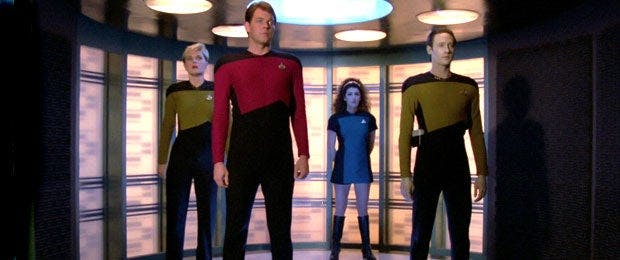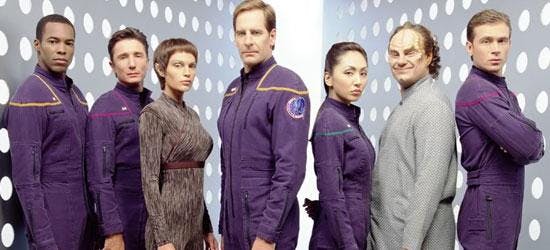Published Jul 25, 2023
Meet Emmy Award-winning Costume Designer Robert Blackman, Part 3
Meet Emmy Award-winning Costume Designer Robert Blackman, Part 3

As much as anyone involved in the modern era of Star Trek, Robert Blackman had a profound effect on what fans saw on The Next Generation (seasons 3-7), Deep Space Nine, Voyager and Enterprise, as well as Generations and First Contact. Blackman’s gig as Star Trek’s costume designer spanned nearly two decades and earned him two Emmy Awards; he was nominated 10 times in total for Star Trek. Since the end of Enterprise, he has worked on Pushing Daisies (for which he won another Emmy), The Cape, Rizzoli & Isles, GCB and, most recently/currently, Glee. Blackman has been way up there on StarTrek.com’s “must-interview” list for several years now, and we’re pleased to say that he has at long last granted us an interview.
The occasion? Blackman will appear as a guest at the upcoming Creation Entertainment Official Star Trek Convention in Las Vegas, set to be held July 31 to August 3. He’s on board to do a Q&A from the stage and will also participate in the planned Cosplay Saturday, part of which will involve him serving as a judge during the Star Trek Las Vegas Costume Competition. Below is the third and final part of our extensive conversation with Blackman, and it kicks off our ongoing series of interviews with guests who’ll be appearing at Creation Entertainment’s Official Star Trek Convention in Las Vegas. Keep an eye on StarTrek.com for a new interview each week, building to the event itself.
Let’s talk about doing the Voyager episode “Bride of Chaotica!”
BLACKMAN: That was our Flash Gordon episode. That was great fun. Oh my gosh, Arachnia was great. All the Ming the Merciless type of stuff was great. You don’t expect to do that kind of thing, so it’s a pleasure when you do get the chance.

Let’s move on to Enterprise. What were the joys and challenges of designing for that show?
BLACKMAN: Because it was a prequel, we really went with the idea that there’d be some NASA in there, but that it’d still be in the Star Trek mode. First of all, though, I said, “We’re going to see closures.” I had spent, at that point, 12 years trying to make everything look like you didn’t know how they got into it, that they were just wearing it. So I said, “There’s going to be zippers. There’s going to be pockets. There will be things for equipment.” There were 13 zippers in each one of those uniforms. There were zippers to nowhere, in a way. Some of them sewn down with a zipper, so that you could never get anything into it, but it just made the characters look a little bit more like cowboys in space. It definitely had a much more masculine and rough edge to it. There was nothing Spandex-y or woolly about them.
You won two Emmys and were nominated in total for 10 for your work on Star Trek. What did that acknowledgement from your peers mean to you and your team?
BLACKMAN: It was a team effort, and it felt great. I was nominated all those times for something that was like a cable show, because Star Trek didn’t do the kinds of numbers like the bigger network shows. We set boundaries for a world and every week we had a different world. Our regulars wore what they wore, but every week, usually, there were other characters wearing something else. What was interesting is you’re only allowed to submit one episode for an Emmy nomination. They don’t nominate series; they nominate one episode. But I think, all in all, my peer group and those people who watched Star Trek, understood the work involved and put me up for those nominations. It was great. Sometimes I’d do a big, gigantic episode of Star Trek and lose to Murphy Brown, where they had a big party and a lot of suits, and they won. That was always a little tough. But I won a couple. One of them I won was for a Majel (Roddenberry) episode, as a matter of fact.
If we made you pick one single costume, from across all your work and all your years with Star Trek, what’s the one that you love most?
BLACKMAN: Ooooh. Ummmm. There are a couple. One of them is the original Seven of Nine outfit, because the engineering of that thing was amazing. Then, the other thing that comes to mind is the Enterprise away suits, the helmeted away suits, which were the first ones we designed. They were originally used in First Contact and then I had to modify them all and make them work on Voyager. They weren’t from scratch for Voyager. They were from scratch for Enterprise. I knew all the things the previous suits did not do, and we tried to build that in for the Enterprise suits. I just loved the way they looked. I was happy with those.
What’s the outfit you wish no one ever saw?
BLACKMAN: Because they were all a work in progress, there’s nothing that I hate. There’s nothing I’d say, “If I could edit this out, I’d do it in a hot second.” The other part of it is anything I didn’t love was usually juxtaposed with something really good. There was something we did very last-minute and desperately for DS9 that wasn’t my favorite thing, but I can’t even remember the name of the alien.

You went into TNG not sure if designing the future was for you and you ended up spending 16 years doing Star Trek. So, how disappointed were you when it all ended after season four of Enterprise?
BLACKMAN: It was hard for everybody who’d been there a long time. And it was hard because I loved Enterprise. Everyone on it was great. Scott Bakula was a great captain and a great person, and he became a personal friend. I didn’t want it to end because you just went down the list, and they were all really good. I think what happened with Enterprise was instead of trying to come up with something totally new, they tried to split the hair one more time, and there wasn’t any hair left to split. But I was sad to see it end. I was hoping it would go the seven seasons because that fit into other game plans I had. But it put me back out into the world. I did theater again for two years and then I said, “Maybe it’s a little early, but I think I’ll retire,” because nothing was coming my way. And then I got a call about Pushing Daisies, with my old friend (longtime Trek writer-producer) Bryan Fuller. He called for me out of the blue and ultimately they didn’t see anyone else. They just hired me. And that was put me in a great place to transition to other shows. So I was able to reinvent myself because of Pushing Daisies, which I probably would not have been able to do had it not been for that show. I’m very grateful to a lot of people for all the opportunities I’ve had. I’m grateful to Rick Berman, grateful to Brannon Braga, grateful to Ira Behr and grateful to Bryan Fuller.
And what are you working on now?
BLACKMAN:Glee. I did this last season, season five. It’s different from anything else I’ve done. It’s so ambitious and so big and, because of that, it’s a lot of really just rushing and getting things done quickly, really quickly. The numbers are large. There can be 150, 200 people. Some of them are in the background, but they still have to be dealt with.
Let’s bring it full circle. You worked with Whoopi Goldberg on TNG. How did you enjoy reuniting with her on Glee? Did she remember you from Trek?
BLACKMAN: She certainly did. And she didn’t want any Guinan in her (Glee) outfits at all. The Guinan thing was interesting because Whoopi developed her interest in non-obtrusive clothing as Guinan. The character had those tunics and pants that were loose-fitting rather than form-fitting, and I think that’s gone on into her everyday life. That’s just sort of what she wears.
Click HERE to read part one of our interview with Robert Blackman and HERE to read part two. And visit creationent.com to purchase tickets to the Official Star Trek Convention in Las Vegas.

